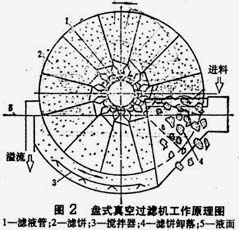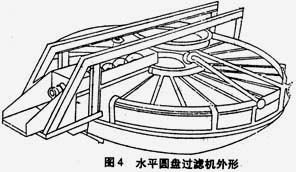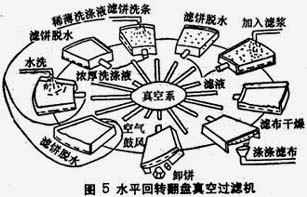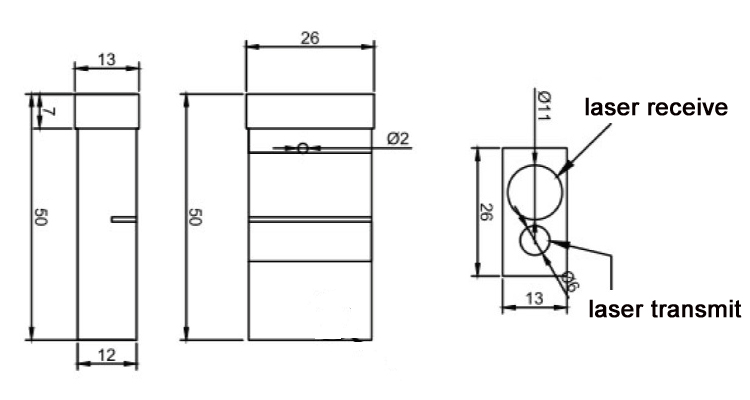Classification and introduction of disc vacuum filter

The vertical disk vacuum filter, also known as the butterfly vacuum filter (Figs. 1 and 2), has a different filtering surface configuration than the cylindrical filter, but the operating principle is basically the same. The filtering surface is composed of a plurality of individual segments forming a plurality of (generally 10 to 12) disks. Each of the segments is a separate filter unit, and the filter cloth is made into a bag sleeve on the segment to form a filter chamber. During operation, the filter disc rotates clockwise, and the solid particles in the slurry adhere to the filter disc by vacuum to form a filter cake. The agitator swings back and forth to prevent solid precipitation. After the filter cake leaves the liquid level, the water is continuously removed under vacuum. The filtrate penetrates the filter cloth, enters the filter tray, passes through the filtrate tube, and is discharged from the dispensing head. The filter cake is discharged from the inside and outside through the filter disc in the discharge area.
The fan-shaped piece is fixed on the main shaft (hollow shaft) by screw inspection, and it is convenient to disassemble and replace the filter cloth, and even can be carried out during the operation of the filter machine, which brings convenience to production maintenance.
China's prototype 60 m 2 vertical disc vacuum filter consists of 6 discs. In the flocculation reverse flotation process of Baotou Steel, the filtration -0.038 mm (-400 mesh) accounts for more than 95% of the flotation iron concentrate, the filter cake moisture is 14-16%, and the unit production capacity is 0.31~0.43% ton / ( Meter 2·time). Filter copper sulfide concentrate, the filter cake moisture is 12-14%, and the unit production capacity is 0.2 tons/(m2·h) or more.
(2) Horizontal disc vacuum filter

This machine is also called flat disk or water platform type vacuum filter, and its structure is shown in Figure 3 and Figure 4. The filtering surface is in the shape of a truncated cone. There are concentric inner and outer rims of a certain height on the disc surface. Below the filter surface, a plurality of radially vertical partitions are divided into a plurality of independent fan-shaped filter chambers, which are connected to the automatic shutters under the disc. The slurry is evenly fed from the top weft-shaped distributor to the fan-shaped filter leaves. The filter residue is scraped off onto a screw conveyor or belt conveyor with a scraper. The filtrate is discharged into the filtrate tank through the outlet below the filter leaf, the filtrate tube and the central dispensing head. The filter cake can be washed several times. The wash solution and filtrate can be collected separately. In order to eliminate the obstruction of the remaining filter cake from the next filtration, compressed air is introduced at the feed point and the residual filter cake is blown back into the newly fed slurry.
The horizontal disc over-the-air filter has a large area, and the filter cloth is easy to be blocked and easily broken. It is generally used for filtering a slurry which requires a good washing effect and contains a large density of coarse solids, and can also filter a slurry containing suspended particles of a smaller density solid.
The filter area of ​​the conventional structure type filter is about 1 to 14 m2, and the Zui is only 20 m2. However, if the fan-shaped filter chamber is folded from one plate, it can be made into a large filter area of ​​250 m2. machine.
(3) Horizontal rotary turn vacuum filter
This machine is also called vertical turntable dump vacuum filter. Its structural principle is shown in Figure 5.

The annular filtering surface is formed by a plurality of independent fan-shaped filter discs, and the filtrate outlet of the filter disc is in communication with the central dispensing tube head. Each fan-shaped filter disc is mounted on a rotating table. The slurry is fed to the filter disc through a dispenser and filtered under vacuum suction. The filtrate is discharged through a central suction tube and a branch pipe and a central dispensing head. The filter cake is left on the filter cloth, and after three stages of washing, it enters the discharge area, and the filter tray is turned 180° and is removed by gravity or compressed air backflushing. Thereafter, the filter disc is reset, after washing and vacuum drying, it is transferred to the feed position to start a new filtration cycle.
The machine is suitable for filtering coarse particle slurry with high density and high concentration, such as phosphate, gypsum, manganese dioxide, potassium carbonate, iron sand, iron ore and other special materials.
At present, Zui's large turn-over filter has an area of ​​205 m 2 and a diameter of 23 m. The capacity to handle P2O5 is 1,000 tons per day.
Long distance LiDAR sensor IT03M series are particularly easy to communication thanks to their fixed connector, which can be plugged it up and off by yourself. Voltage is wider from 3.3v before to 3.6v. Low power consumption feature makes it beceome a very competitive, high performance-price ratio, long range Laser Distance Sensor.
Highlights:
> Measurement frequency: 100 Hz (Max 200 Hz)
> High temperatures: -10~+50℃
> UART output
> Connector design: easy to use

Parameters of IT03M:
|
Accuracy |
+/-5cm@ 0.1~2.5m |
|
Measuring Unit |
cm |
|
Measuring Range (without Reflection) |
0.1-15m |
|
Measuring Time |
0.1~3 seconds |
|
Measuring Frequency |
100 Hz |
|
Laser Class |
Class II |
|
Laser Type |
650nm, <1mw, red |
|
Weight |
About 10g |
|
Voltage |
DC2.5V~+3.5V |
|
Serial Level |
TTL 3.3V |
|
Size |
50*26*13mm |
|
Operating Temperature |
0-40 ℃ (32-104 ℉ ) |
|
Storage Temperature |
-25~60 ℃ (-13~140 ℉) |
Speed Laser Sensor,Long Range Lidar,Long Range 3D Lidar,Long Range Radar Sensor
Chengdu JRT Meter Technology Co., Ltd , https://www.cdlaserdistancemodule.com